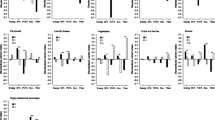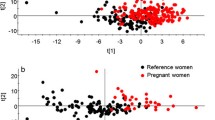Abstract
Objective: To assess diet quality of pregnant women in the WIC program in North Dakota and to compare Native Americans with whites, we used a DQI-P (diet quality index for pregnancy) among low-income pregnant women enrolled in WIC, a special supplemental program for women, infants, and children. Methods: Dietary information was collected for all participants using the Harvard Service Food Frequency Questionnaire (HSFFQ). DQI-P scores were based on 10 components previously used in other diet quality indices: percent recommended intake of grains, vegetables, fruits, folate, calcium, and iron; total fat, saturated fat, and cholesterol; and dietary diversity. Each component contributed 10 points to the total possible DQI-P score of 100. Results: The mean DQI-P score was 53.9. Native Americans (51.8) had significantly lower DQI-P scores (51.8 vs. 54.2; p<0.0001); significantly higher scores for iron and folate; and significantly lower scores for cholesterol, total fat intake, and saturated fat components than did whites. As DQI-P scores increased, diet improved and scores for individual components increased. Conclusion: While there were significant differences between the diet quality of Native American and white pregnant women, the differences were minimal. The DQI-P scores for all women in this population indicate that their diets are not meeting dietary recommendations. Interventions should focus on decreasing fat intake and increasing iron and folate intake to meet national dietary recommendations. More emphasis should be placed on eating whole fruit and vegetables.
Similar content being viewed by others
References
Institute of Medicine. Nutrition during pregnancy: weight gain and nutritional supplements. Washington DC: National Academy Press; 1990.
Mardis AL, Anand R. A look at the diet of pregnant women. 2001;13:55–57. [Online]. Available: http://www.usda.gov/cnpp/FENR/FENRv13n2/ Accessed 24 April 2005.
Abrams B, Altman SL, Pickett KE. Pregnancy weight gain: still controversial. Am J Clin Nutrit 2000;71:1233S–41S.
Perry GS, Zyrkowski CL, Clark LS, Yu S. Pregnancy-related nutrition. In from data to action: CDC’s public health surveillance for women, infants, and children. In: Wilcox LS, Marks JS editors. Centers for Disease Control and Prevention, U.S. Department of Health and Human Services; 1994; p. 119–28.
Fowles ER. Prenatal Nutrition and birth outcomes. J Obstet, Gynecol Neonatal Nurs 2004;33:809–22.
Reifsnider E, Gill SL. Nutrition for the childbearing years. J Obstet, Gynecol Neonatal Nurs 2000;29:43–55.
Fowles ER. Comparing Pregnant Women’s Nutritional Knowledge to their actual dietary intake. MCN Am J Matern Child Nurs 2002;27:171–7
Phillip W, James T, Nelson M, Ralph A. Leather S. Socioeconomic determinants of health: The contribution of nutrition to inequalities in health. BMJ. 1997;314:1545.
Wilkins DE. Native American politics and the American political system. Lanham, MD: Rowman & Littlefield Publishers, Inc.; 2002.
Snipp M. Selected demographic characteristics of Indians. In ER Rhoades (Eds.) American Indian Health: Innovations in Health Care, Promotion, and Policy. Baltimore, MD: The Johns Hopkins University Press; 2000. pp. 41–57.
Martin JA, Hamilton BE, Sutton PD, Ventura SJ, Menacker F, Munson ML. Births: final data for 2002. Natl Vital Stat Rep 2003;52:1–113.
Baldwin, LM, Grossman DC, Casey S, Hollow W, Sugarman JR, Freeman WL, Hart LG. Perinatal and Infant Health among rural and urban Native Americans/Alaska Natives. Am J Public Health 2002;92:1491–7.
Indian Health Service, Office of Public Health, Office of Program Support, Division of Program Statistics. Trends in Indian health 1998–99. [Online]. Available: http://www.ihs.gov/publicinfo/publications/trends98/part3.pdf Accessed 10 March 2005.
U.S. Department of Health and Human Services, U.S. Department of Agriculture. Dietary Guidelines for Americans. 2005. Available: http://www.health.gov/dietaryguidelines/dga2005/document/pdf/DGA2005.pdf Accessed 10 March 2005.
Shaw A, Fulton L, Savis C, Hogbin M. Using the Food Guide Pyramid: A Resource for Nutrition Educators [Online] Available at http://www.nal.usda.gov/fnic/Fpyr/guide.pdf Accessed 10 March 2005.
Kennedy ET, Ohls J, Carlson S, Fleming K, The Healthy Eating Index: design and applications. J Am Diet Assoc 1995;95:1103–8.
Haines PS, Siega-Riz AM, Popkin BM. The diet quality index revised: a measurement instrument for populations. J Am Diet Assoc 1999;99:697–704.
Kant AK. Indexes of overall diet quality: a review. J Am Diet Assoc 1996;96:785–91.
Bodnar LM, Siega-Riz AM. A diet quality index for pregnancy detects variation in diet and differences by sociodemographic factors. Public Health Nutr 2002;5:801–9.
Bitler MP, Curie J. Does WIC work? The effects of WIC on pregnancy and birth outcomes. J Policy Anal Manage 2005;24:73–91.
Willett W, Sampson L, Stampfer MJ, Rosner B, Bain C, Witschi J, Hennekens CH, Speizer FE. Reproducibility and validity of semi-quantitative food frequency questionnaire. Am J Epidemiol 1985;122:51–65.
Wei EK, Gardner J, Field AE, Rosner BA, Colditz GA, Suitor CW. Validity of a food frequency questionnaire in assessing nutrient intakes of low-income pregnant women. Matern Child Health J 1999;3:241–6.
Baer HJ, Blum RE, Rockett HRH, Leppert J, Gardner JD, Suitor CW, Colditz GA. Use of a food frequency questionnaire in American Indian and Caucasian pregnant women: a validation study. BMC Public Health 2005;5:135–45.
U.S. Department of Agriculture Nutrient Database for Standard Reference Version Release 10. Washington, DC: U.S. Government Printing Office.
U.S. Department of Agriculture Nutrient Database for Standard Reference Version Release 11. Washington, DC: U.S. Government Printing Office.
Holland B, Welch AA, Unwin ID, Buss DH, Paul AA, Southgate DAT, McCance and Widdowson’s The Composition of Foods. 5th edition. Cambridge, UK: Royal Chemical Society and Ministry of Agriculture, Fisheries, and Food; 1991.
Paul AA, Southgate DAT. McCance and Widdowson’s The Composition of Foods. 4th edition. London, UK:H.M. Stationery Office; 1976.
Yates AA, Schlicker SA, Suitor CW. Dietary Reference Intakes: The new basis for recommendations for calcium and related nutrients, B vitamins, and choline. J Am Diet Assoc 1998;98:699–706.
National Academies. Dietary Reference Intakes. [Online]. Available: http://www.iom.edu/Object.File/Master/7/294/0.pdf Accessed 10 March 2005.
U.S. Department of Agriculture, U.S. Department of Health and Human Services. Nutrition and Your Health: Dietary Guidelines for Americans, fourth edition. Home and Garden Bulletin 232. 1995.
Kennedy E, Bowman SA, Lino M, Gerrior SA, Basiotis PP. Diet Quality of Americans. [Online]. Available: http://www.ers.usda.gov/publications/aib750/aib750e.pdf Accessed 10 March 2005.
U.S. Department of Health and Human Services, U.S. Department of Agriculture. Dietary Guidelines for Americans. 2005. Available: http://www.health.gov/dietaryguidelines/dga2005/document/pdf/DGA2005.pdf
Koop-Hoolihan LE, van Loan MD, Wong WW, King JC. Longitudinal assessment of energy balance in well-nourished, pregnant women. Am J Clin Nutr 1999;69(4):697–704.
Food and Nutrition Board. Diet and Health: Implications for reducing chronic disease risk. Washington, DC: National Academy Press; 1989.
Pick ME, Edwards M, Moreau D, Ryan EA. Assessment of diet quality in pregnant women using the Healthy Eating Index. J Am Diet Assoc 2005;105:240–6.
Swensen AR, Harnack LJ, Ross JA. Nutritional assessment of pregnant women enrolled in the special supplemental program for women, infants, and children (WIC). J Am Diet Assoc 2001;101:903–908.
Acknowledgements
This study was supported by grant # RO1 HD 33763 from the National Institutes of Health. Dr. Colditz is also supported by the American Cancer Society Cissy Hornung Clinical Research Professorship. The authors gratefully acknowledge the North Dakota WIC clients who participated in this study and the dietitians who collected the data. The authors would also like to acknowledge the assistance of Robin EB Flaig, at the Harvard School of Public Health, as well as the contributions of Jill Leppert, of the North Dakota WIC Program, Division of Maternal and Child Health, for her active collaboration in the preparation of this manuscript. Unfortunately, prior to the completion of the manuscript, Jill Leppert passed away.
Author information
Authors and Affiliations
Corresponding author
Additional information
This author is deceased.
Rights and permissions
About this article
Cite this article
Watts, V., Rockett, H., Baer, H. et al. Assessing Diet Quality in a Population of Low-Income Pregnant Women: A Comparison Between Native Americans and Whites. Matern Child Health J 11, 127–136 (2007). https://doi.org/10.1007/s10995-006-0155-2
Received:
Accepted:
Published:
Issue Date:
DOI: https://doi.org/10.1007/s10995-006-0155-2




